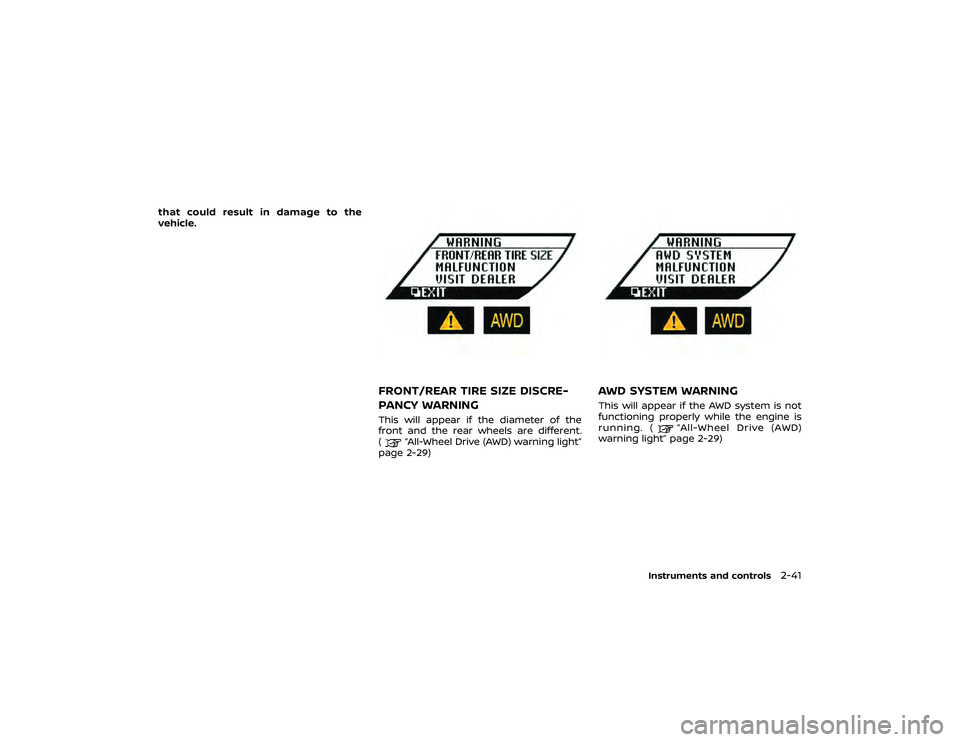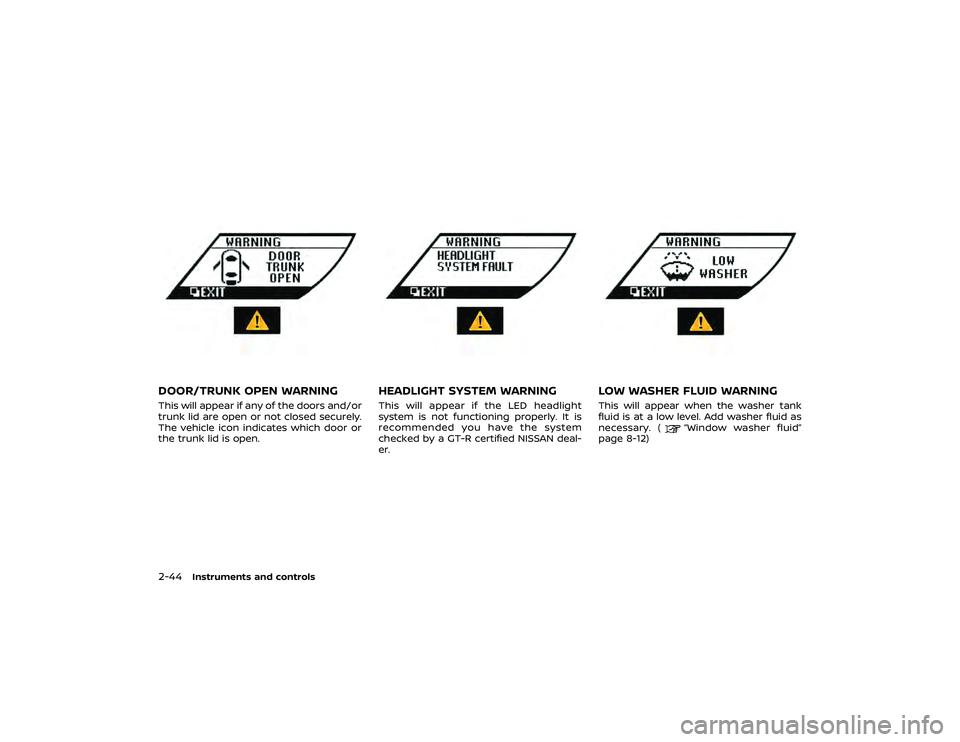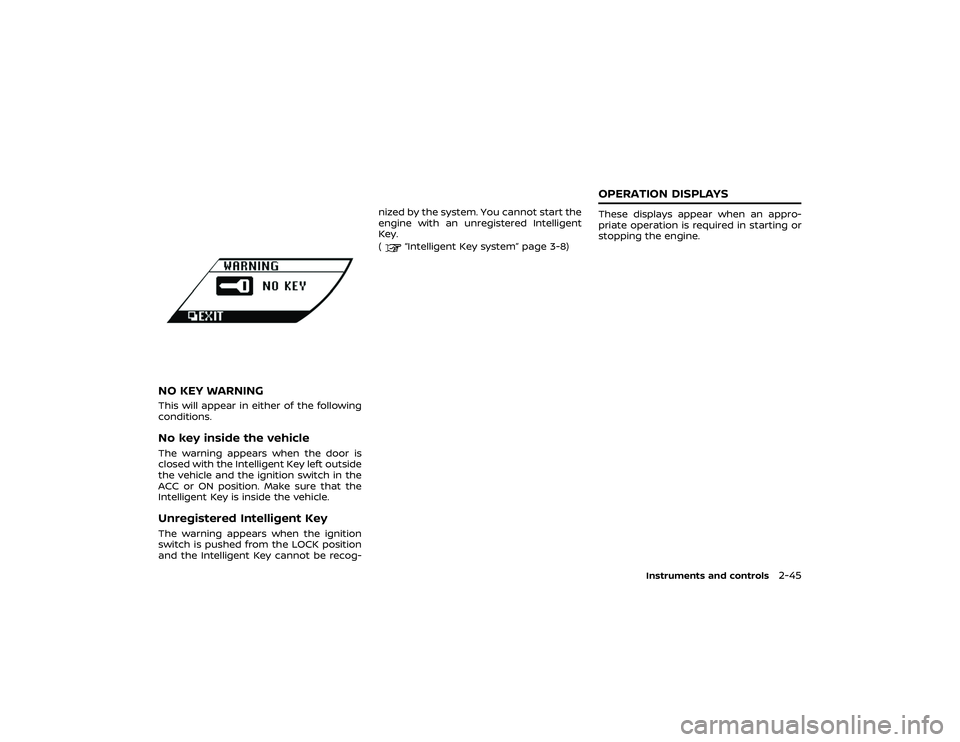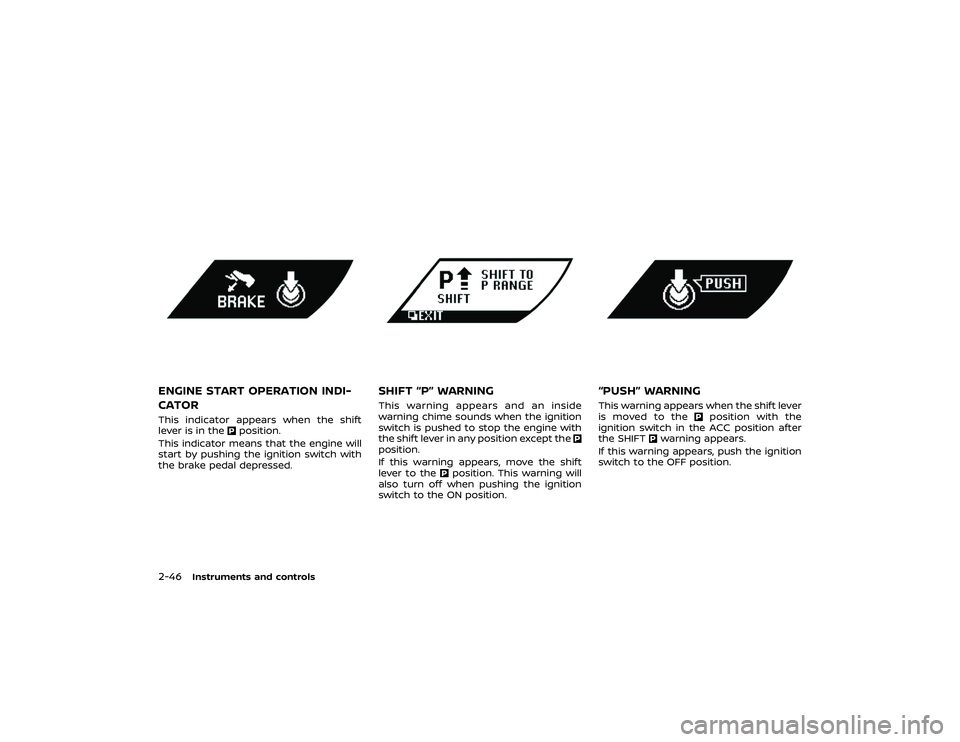NISSAN GT-R 2022 Owners Manual
Manufacturer: NISSAN, Model Year: 2022, Model line: GT-R, Model: NISSAN GT-R 2022Pages: 1808, PDF Size: 4.88 MB
Page 141 of 1808

Page 142 of 1808

Example
TIRE LABELING
Federal law requires tire manufac-
turers to place standardized infor-
mation on the sidewall of all tires.
This information identifies and de-
scribes the fundamental character-
istics of the tire and also provides
the tire identification number (TIN)
for safety standard certification.
The TIN can be used to identify
the tire in case of a recall.
Page 143 of 1808

Tire ply composition and material
The number of layers or plies of
rubber-coated fabric in the tire.
Tire manufacturers also must in-
dicate the materials in the tire,
which include steel, nylon, polye-
ster, and others.Maximum permissible inflation
pressure
This number is the greatest
amount of air pressure that should
be put in the tire. Do not exceed the
maximum permissible inflation
pressure.Maximum load rating
This number indicates the maxi-
mum load in kilograms and pounds
that can be carried by the tire.
When replacing the tires on the
vehicle, always use a tire that has
Do-it-yourself
8-35
Page 144 of 1808

the same load rating as the factory
installed tire.
The word “radial”
The word “radial” is shown, if the
tire has radial structure.Manufacturer or brand name
Manufacturer or brand name is
shown.
Other tire-related terminology:
In addition to the many terms that
are defined throughout this sec-
tion, Intended Outboard Sidewall is
(1) the sidewall that contains a
whitewall, bears white lettering or
bears manufacturer, brand and/or
model name molding that is higher
or deeper than the same molding
on the other sidewall of the tire, or
(2) the outward facing sidewall of
an asymmetrical tire that has a
particular side that must always
face outward when mounted on a vehicle.
TYPES OF TIRES
WARNING
.
When changing or replacing tires,
be sure all four tires are of the
same type (Examples: Summer or
All Season) and construction. A
GT-R certified NISSAN dealer may
be able to help you with informa-
tion about tire type, size, speed
rating and availability.
. Replacing tires with those not
originally specified by NISSAN
could affect the proper operation
of the TPMS.
. For additional information re-
garding tires, refer to “Important
Tire Safety Information” (US) or
“Tire Safety Information” (Cana-
da) in the Warranty Information
Booklet.All-season tiresNISSAN specifies all-season tires on some
models to provide good performance for
use all year around, including snowy and
icy road conditions. All-season tires are identified by ALL SEASON on the tire
sidewall.
Summer tiresThe GT-R summer tires are made from a
specially formulated rubber to maximize
the vehicle’s performance capabilities.
Performance of summer tires is substan-
tially reduced when temperatures are less
than 32°F (0°C) so you must drive care-
fully. NISSAN recommends the use of
winter or all-season tires on all four
wheels if you plan to operate your vehicle
in snowy or icy conditions when tem-
peratures are less than 32°F (0°C).
Page 145 of 1808

ways use run-flat tires of the specified
size on all four wheels. Mixing tire sizes or
construction may reduce vehicle handling
stability. If necessary, contact a GT-R
certified NISSAN dealer for assistance.
Frequently check the tire pressure infor-
mation on the touch screen display and
adjust pressure of each tire properly. See
the separate Multi Function Display Own-
er’s Manual.
It can be difficult to tell if a run-flat tire is
under-inflated or flat. Check the tire
pressures as described earlier in this
section. If the tire becomes under-inflated
while driving, the low tire pressure warn-
ing light will come on. If the tire becomes
flat while driving, the low tire pressure
warning light and the run-flat tire warn-
ing display will come on.
Low tire pressure:
NOTICE
.Never install tire chains on a
punctured run-flat tire, as this
could damage your vehicle.
. Avoid driving over any projection
or pothole, as the clearance be-
tween the vehicle and the ground
is smaller than normal.
. Do not enter an automated car
wash with a punctured run-flat
tire.
. It is recommended you have the
punctured tire replaced by a GT-R
certified NISSAN dealer as soon
Do-it-yourself
8-37
Page 146 of 1808

as possible, as the tire
Page 147 of 1808

Page 148 of 1808

being uninstalled from the
wheels, use equipment such as a
leverless automatic tire changer.
It is only possible to reuse the
tires when they have no cracks
and/or deformations on the bead
portion. However, if you use a
lever-type tire changer, cracks
and deformation may occur on
the bead portion of the tires
meaning that the tires cannot be
reused.
. Make sure the tire valve stem cap
is installed and that the valve
stem is tight. When installing the
cap, make sure to tighten the cap
by hand. If a tool is used to
tighten the cap, the cap may be
damaged.
WARNING
.The use of tires other than those
specified or the mixed use of tires
of different brands, construction
(bias, bias-belted, radial or run-
flat), or tread patterns can ad-
versely affect the ride, braking,
VDC system, handling, ground
clearance, body-to-tire clearance, tire chain clearance, speed-
ometer calibration, headlight
aim and bumper height. Some of
these effects may lead to acci-
dents and could result in serious
personal injury.
. If the wheels are changed for any
reason, always replace with
wheels which have the same off-
set dimension. Wheels of a differ-
ent off-set could cause prema-
ture tire wear, degrade vehicle
handling characteristics, affect
the VDC system and/or cause
interference with the brake discs.
Such interference can lead to
decreased braking efficiency
and/or early brake pad wear.
(
“Wheels and tires” page 10-
10)
. When a wheel is replaced, tire
pressure will not be indicated,
the TPMS will not function and
the low tire pressure warning
light will flash for approximately
1 minute and remain on after the
1 minute. It is recommended you
contact a GT-R certified NISSAN
dealer as soon as possible for tire
replacement and/or system re-
setting. .
Replacing tires with those not
originally specified by NISSAN
could affect the proper operation
of the TPMS.
. The TPMS sensor may be da-
maged if it is not handled cor-
rectly. Be careful when handling
the TPMS sensor.
. When replacing the TPMS sensor,
the ID registration may be re-
quired. Contact a GT-R certified
NISSAN dealer for ID registration.
. Do not use a valve stem cap that
is not specified by NISSAN. The
valve stem cap may become
stuck.
. Be sure that the valve stem caps
are correctly fitted. Otherwise the
valve may be clogged up with dirt
and cause a malfunction or loss
of pressure.
. Do not install a damaged or
deformed wheel or tire even if it
has been repaired. Such wheels
or tires could have structural
damage and could fail without
warning.
. Never use retread tires.
. For additional information re-
Page 149 of 1808

garding tires, refer to “Important
Tire Safety Information” (US) or
“Tire Safety Information” (Cana-
da) in the Warranty Information
Booklet.
. Always use tires of the specified
type, size, brand, construction
(bias, bias-belted, radial or run-
flat), and tread pattern on all four
wheels. Failure to do so may
result in a circumference differ-
ence between tires on the front
and rear axles which will cause
excessive tire wear and may da-
mage the transmission, transfer
case and differential gears.
Wheel balanceUnbalanced wheels may affect vehicle
handling and tire life. Even with regular
use, wheels can get out of balance.
Therefore, they should be balanced as
required.
Wheel balance service should be per-
formed with the wheels off the vehicle.
Spin balancing the rear wheels on the
vehicle could lead to mechanical damage.
For additional information regarding tires,
refer to “Important Tire Safety Informa-
tion” (US) or “Tire Safety Information” (Canada) in the Warranty Information
Booklet.
Care of wheels(
“Cleaning exterior” page 7-2)
JACKING VEHICLE AND REMOVING
WHEELS
WARNING
.
Make sure the parking brake is
securely applied and the trans-
mission is shifted into the
position.
. Never change tires when the ve-
hicle is on a slope, ice or slippery
areas. This is hazardous.
. Never change tires if oncoming
traffic is close to your vehicle.
Wait for professional road assis-
tance.
Blocking wheelsPlace suitable blocks
at both the front
and back of the wheel diagonally oppo-
site the flat tire to prevent the vehicle
from moving when it is jacked up.
Page 150 of 1808

CAUTION
After using the tools, put them back
in their original places. An accident
may occur if you leave them in the
car unsecured.Jacking up the vehicle and re-
moving the tire
WARNING
.Never get under the vehicle while
it is supported only by the jack. If
it is necessary to work under the
vehicle, support it with safety
stands.
. Use the correct jack-up points.
Never use any other part of the
vehicle for jack support.
. Never jack up the vehicle more
than necessary.
. Never use blocks on or under the
jack.
. Do not start or run the engine
while vehicle is on the jack, as it
may cause the vehicle to move.
This is especially true for vehicles with limited slip differentials.
. Do not allow passengers to stay
in the vehicle while it is on the
jack.
Carefully read the caution label at-
tached to the jack body and the follow-
ing instructions.